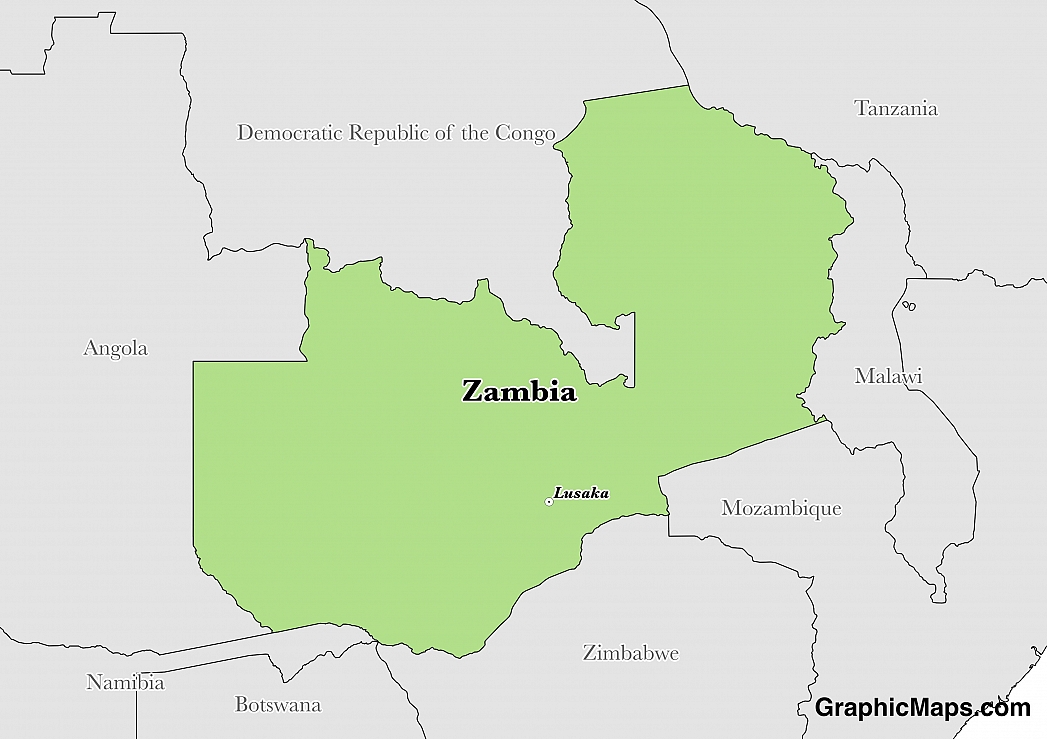Where is Zambia?
Located in Southern Africa, Zambia has a 6,043.00 km border with Angola (1,065 km), Botswana (0.15 km), Democratic Republic of the Congo (2,332 km), Malawi (847 km), Mozambique (439 km), Namibia (244 km), Tanzania (353 km) and Zimbabwe (763 km). In 2004, Zimbabwe dropped objections to plans between Botswana and Zambia to build a bridge over the Zambezi River.
The capital of Zambia is Lusaka, which is located in the central region of the country near the southern border. It sits in the central plateau geographic region at an altitude of approximately 4,196 feet above sea level. It cover an area of 161 square miles in the province and district of Lusaka. In 1935, Lusaka was officially designated as the capital of the British colony, then known as Northern Rhodesia. It maintained its administrative status when Zambia gained its independence in 1964. The population of Lusaka city proper is a little over 1.74 million, although the entire metropolitan area has more than 2.46 million residents. The residents here represent a wide range of ethnic diversities as well as some small populations of foreign immigrants. Lusaka is a relatively popular tourist destination in Zambia, although most visitors tend not to stay here for long. It has very few tourist attractions, although these range over a number of interests. Some of the most popular sites are: the Munda Wanga Environmental Park, the Soweto Market, and the National Museum. Lusaka is located in a humid subtropical climatic zone.
Read more on Zambia's CapitalZambia is an African country covering 752,618.00 km2 of which 1.23% is water and 743,398.00 km2 is land. This makes it the 38th largest country in the world and almost five times the size of Georgia slightly larger than Texas. Its geographic coordinates are 15 00 S, 30 00 E and Lusaka is the capital city.
Its name derives from the Zambezi River.
Its ISO code is ZM.
Geography
Zambia has a mean elevation of 1,138 m above sea level.
The climate is tropical and modified by altitutde, with a rainy season from November to March. Its terrain consists mostly of high plateaus with some hills and mountains.
Population
Zambia has a population of 15,510,711 making it the 69th largest in the world.
Bembe, Nyanja, Tonga, and Lozi are all widely spoken. The most common ethnic groups are Bemba, Tonga, Chewa, Nsenga, and Tumbuka. The majority of the population is Protestant Christian.
English is the only official language of Zambia even though this country is considered multilingual. This language was first introduced to the area by British colonizers and was made the official language of the government during the colonial era. Since Zambia gained its independence, English has remained the working language of the government of Zambia, as well as of the mass media, public school instruction, and business and trade. Despite this, only around 1.91 million individuals (of the entire population of over 16.59 million) can speak or understand the English language. The most widely spoken language in this country is Bemba, with around 3.81 million speakers. This is followed by Chewa (2.18 million speakers), Tonga (1.33 million speakers, and Lozi (612,000 speakers).
Read more on Zambia's LanguagesThe dialing code for the country is 260.
Government
Zambia is an independent country. It gained independence from the United Kingdom in 1964. Its constitution was last ratified in 2016.
The government of Zambia is carried out under the framework of a presidential republic, which means the citizens of this country elect individuals to represent their interests in government. The President of Zambia leads the country by serving as both the Head of State and the Head of Government. The legislative branch is represented by the National Assembly of Zambia, a unicameral body made up of 158 representatives. Of these 158 members, 150 represent single constituencies and 8 are appointed by the President. All citizens over the age of 18 are eligible to vote in the elections of Zambia. These individuals elect the President and the National Assembly members to serve a 5-year term. The National Assembly meets in the Parliament building in the business district of Lusaka, the national capital. The public can visit this building after submitting a written request to the clerk.
Read more on Zambia's GovernmentEconomy
Factoring in Purchasing Power Parity, Zambia's GDP is $65,170,000,000.00 (USD) with $3,900.00 (USD) per capita. This makes it the 100th largest economy and its citizens the 171st richest in the world. The currency of Zambia is the Kwacha (ZMK).
Its major export partners are Switzerland, China, and Singapore. Its main exports are copper, cobalt, electricity, flowers, and tobacco. Its major import partners are South Africa, the Democratic Republic of the Congo, and China. Its major imports include machinery, transportation equipment, and petroleum products.
Flag
The national flag of Zambia is characterized by its kelly green color, which covers the majority of its background. It also has an emblem of an African fish eagle in the upper right corner. This bird is a nation symbol for the country and stands for the strength and upward mobility of Zambia. In the lower right side of the flag is a tricolor, vertical rectangle. Its stripes are red, black, and orange (from left to right). Each of the colors on this flag has a specific meaning for Zambia. The current design of this flag is based on the flag of the United National Independence Party, which is the political party that first began the movement for independence. Zambia officially adopted its flag on October 24, 1964, the day it became independent.
Read more on Zambia's FlagThis page was last modified on January 17th, 2018
More on Graphicmaps

Published on 2019-11-06
What is a Trade Embargo?

Published on 2019-11-04
Which Two Countries Used to Have the Same Flag?

Published on 2019-09-16
What Is the Only Two-Sided State Flag?

Published on 2019-09-16
Which Country Flag Looks Like the Texas Flag?

Published on 2019-08-29
Flags That Resemble the US Flag

Published on 2019-08-20
